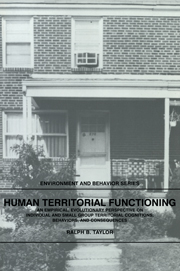 Human Territorial Functioning
Human Territorial Functioning Book contents
- Frontmatter
- Contents
- List of figures, tables, and boxes
- Series foreword
- Preface
- Acknowledgments
- 1 Introduction
- PART I ORIGINS OF HUMAN TERRITORIAL FUNCTIONING
- PART II A CONCEPTUAL MODEL OF HUMAN TERRITORIAL FUNCTIONING
- PART III TERRITORIAL FUNCTIONING IN SETTINGS OF VARYING CENTRALITY
- 7 Interior residential settings
- 8 Territorial functioning in outdoor residential spaces close to the home
- 9 Regular use settings
- 10 Minimal territorial functioning
- PART IV APPLICATIONS TO SOCIAL PROBLEMS
- PART V REVIEW AND PROSPECTS
- Index
9 - Regular use settings
Published online by Cambridge University Press: 05 February 2010
- Frontmatter
- Contents
- List of figures, tables, and boxes
- Series foreword
- Preface
- Acknowledgments
- 1 Introduction
- PART I ORIGINS OF HUMAN TERRITORIAL FUNCTIONING
- PART II A CONCEPTUAL MODEL OF HUMAN TERRITORIAL FUNCTIONING
- PART III TERRITORIAL FUNCTIONING IN SETTINGS OF VARYING CENTRALITY
- 7 Interior residential settings
- 8 Territorial functioning in outdoor residential spaces close to the home
- 9 Regular use settings
- 10 Minimal territorial functioning
- PART IV APPLICATIONS TO SOCIAL PROBLEMS
- PART V REVIEW AND PROSPECTS
- Index
Summary
We used to go to a bar off Grant Street. Gays used to hang out there. Over several months my wife started getting more approaches, and I fewer, when we visited there. It changed over to a lesbian bar.
– former San FranciscanWhen your desk, shelves, and wall space are covered with mementoes, photographs, trophies, humorous mottoes, and other decorative effects, you are probably not beautifying the office; rather, you may be giving it a jumbled, untidy look. … The proper atmosphere for a business office is one of neatness and efficiency, not hominess.
– Business Etiquette HandbookProceeding down the centrality continuum brings us to regular use settings. These are places frequented on a more or less regular basis by an individual or group, where the individual or group plays some role in maintaining the setting, and/or encounters known others. Territorial functioning in those settings is the focus of this chapter. The settings included in this portion of the centrality continuum are diverse, and more geographically dispersed than the interior residential settings and outdoor spaces near home examined in the previous two chapters. Nonetheless, commonalities across these locations in terms of territorial functioning are evident. It is the relative position of these settings on the centrality continuum that helps explain similarities in territorial functioning in the settings.
The nature of regular use settings is examined and the characteristics of territorial functioning in those locations are outlined. Following the same practice used in the preceding two chapters, evidence of personal, social, physical, and “cultural” predictors of territorial functioning in these settings is presented. The types of places covered include work settings of different types. Arenas in which athletic contests are held are, however, also included. Then, psychological, social psychological, and ecological consequences are noted.
- Type
- Chapter
- Information
- Human Territorial FunctioningAn Empirical, Evolutionary Perspective on Individual and Small Group Territorial Cognitions, Behaviors, and Consequences, pp. 198 - 220Publisher: Cambridge University PressPrint publication year: 1988
